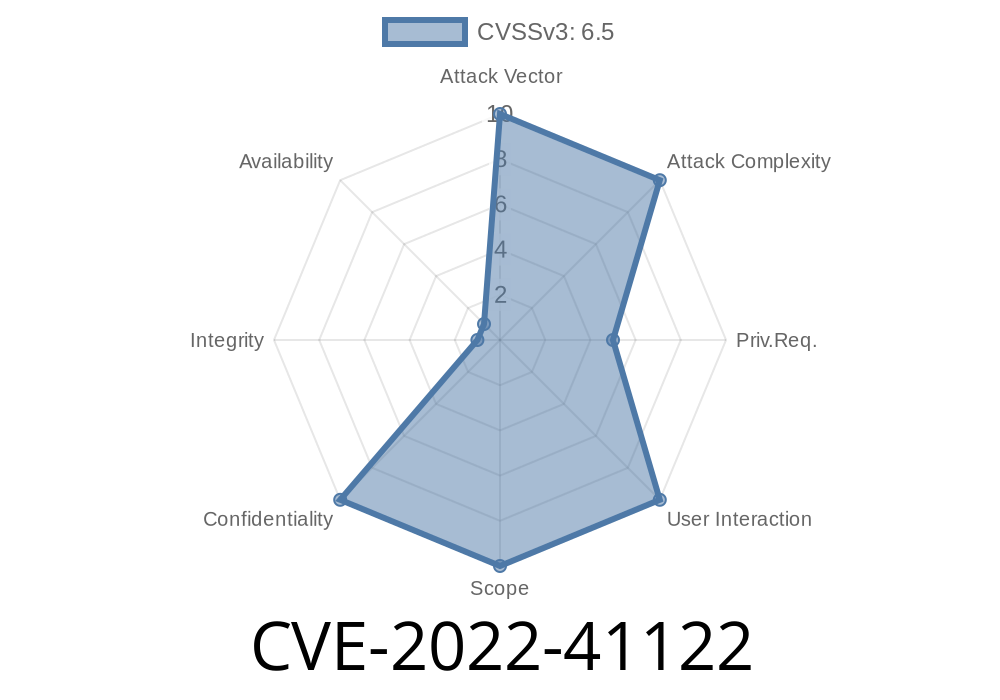Microsoft SharePoint Server, an indispensable collaboration platform for businesses and organizations, recently faced vulnerability (CVE-2022-41122) that could allow an attacker to perform a spoofing attack. Details of the vulnerability, insights into how it could be exploited, and steps to mitigate it are discussed below.
Introduction
In the world of cybersecurity, vulnerabilities in popular enterprise applications pose significant risks to sensitive data and key business functions. One such application, Microsoft SharePoint Server, has come under scrutiny due to the ominous presence of a spoofing vulnerability identified by the CVE identifier, CVE-2022-41122. This comprehensive long-read post delves into the technical insights, highlighting the crux of the vulnerability, referencing the original sources, and shedding light on the exploitation process. The primary focus is to dissect the vulnerability and provide actionable guidance for affected parties in a concise and accessible manner.
Vulnerability Details
The vulnerability, tracked as CVE-2022-41122, was reported for the SharePoint Server. It results from inadequate URL encoding/decoding safeguards, enabling an attacker to potentially manipulate URLs, disguise their own identity by pretending to be someone else, and convince users to click on these malicious URLs.
The Microsoft Advisory states
_"A spoofing vulnerability exists in Microsoft SharePoint Server when it does not properly encode and decode URLs. An attacker who successfully exploited this vulnerability could redirect users to arbitrary sites or potentially disguise their online identity. Users would then be more likely to interact with attacker-controlled content."_ [1]
This marks the kernel of the problem as a URL processing misstep, paving the way for attackers to perform a rather seamless spoofing attack.
Code Snippet
While the exact code causing the vulnerability remains undisclosed, one could imagine that the issue resides in areas of code that handle processing and parsing of URL addresses within SharePoint. The following snippet illustrates a vulnerable function could look like:
// Example of a vulnerable function
public string UnsafeUrlDecode(string input)
{
return Uri.UnescapeDataString(input);
}
In the above code, the UnsafeUrlDecode function might not properly guard against malicious URLs due to incomplete URL encoding and decoding.
Exploit Details
The vulnerability essentially makes users susceptible to spoofing attacks, which arise when an attacker impersonates a legitimate entity. The attacker, in this case, crafts a malicious URL, hiding their true identity and directing users to either their own malicious destinations or arbitrary sites entirely. Unwary users, oblivious to the attack, are coerced into sharing sensitive information or unknowingly download malware.
Below is a step-by-step illustration of how exploitation can occur
1. An attacker creates a URL resembling that of a legitimate SharePoint site, albeit with malicious intent.
The URL is then shared with unsuspecting users via emails, chats, or other communication channels.
3. The victims, upon clicking the malicious URL, are guided to either the attacker's malicious site or an arbitrary destination.
4. The attacker successfully deceives the victim, harvesting their sensitive information, or performing other malicious activities.
Mitigation Steps
To tackle this vulnerability and protect their SharePoint Server, users should implement the following safeguard:
1. Update SharePoint Server: Microsoft has released updates addressing this vulnerability, and it's crucial for affected parties to download and install the latest SharePoint Server patches [2].
2. Educate and Train Users: Employees and end-users should receive education and training to become aware of such vulnerabilities and the potential risks associated with spoofed URLs. This way, users act as a line of defense against spoofing attacks.
3. Implement URL Filtering: Integrating URL filtering and email content filtering solutions can help stop malicious URLs from entering the organization's network, reducing the risk associated with clicking malicious URLs.
Original References
1. Microsoft Advisory: https://msrc.microsoft.com/update-guide/vulnerability/CVE-2022-41122
2. Microsoft SharePoint Server Updates: https://docs.microsoft.com/en-us/sharepoint/security/security-update-best-practices
Conclusion
Microsoft SharePoint Server's recent vulnerability, CVE-2022-41122, presents a spoofing risk to users and organizations. It emphasizes the importance of understanding the fundamentals of the vulnerability, its exploitation possibilities, and the necessity for appropriate mitigations. By implementing the recommendations mentioned above, users and organizations can better protect themselves from such spoofing attacks, ultimately ensuring their SharePoint environment remains secure.
Timeline
Published on: 11/09/2022 22:15:00 UTC
Last modified on: 11/10/2022 00:33:00 UTC
